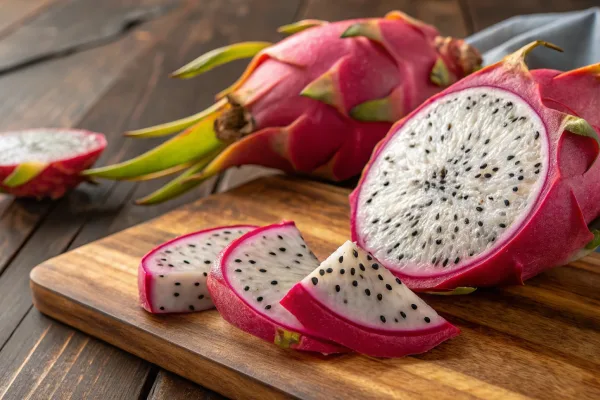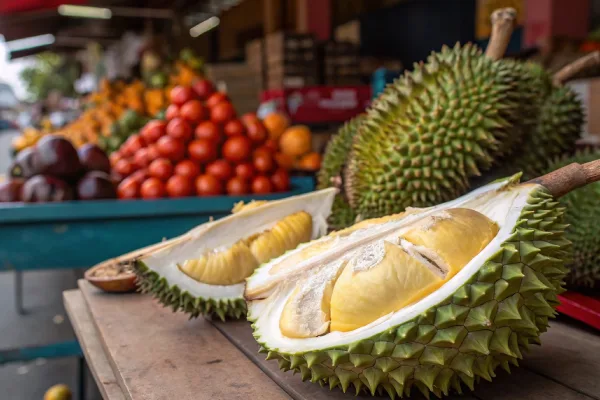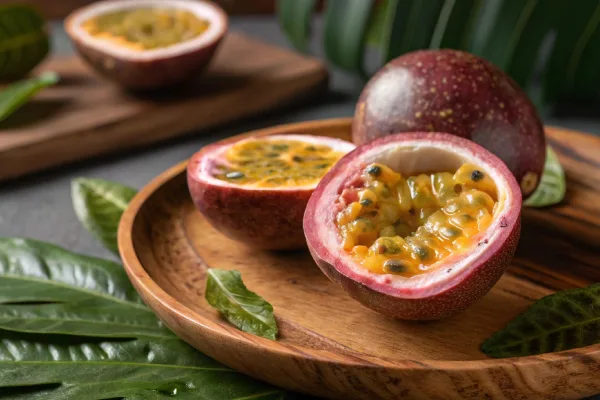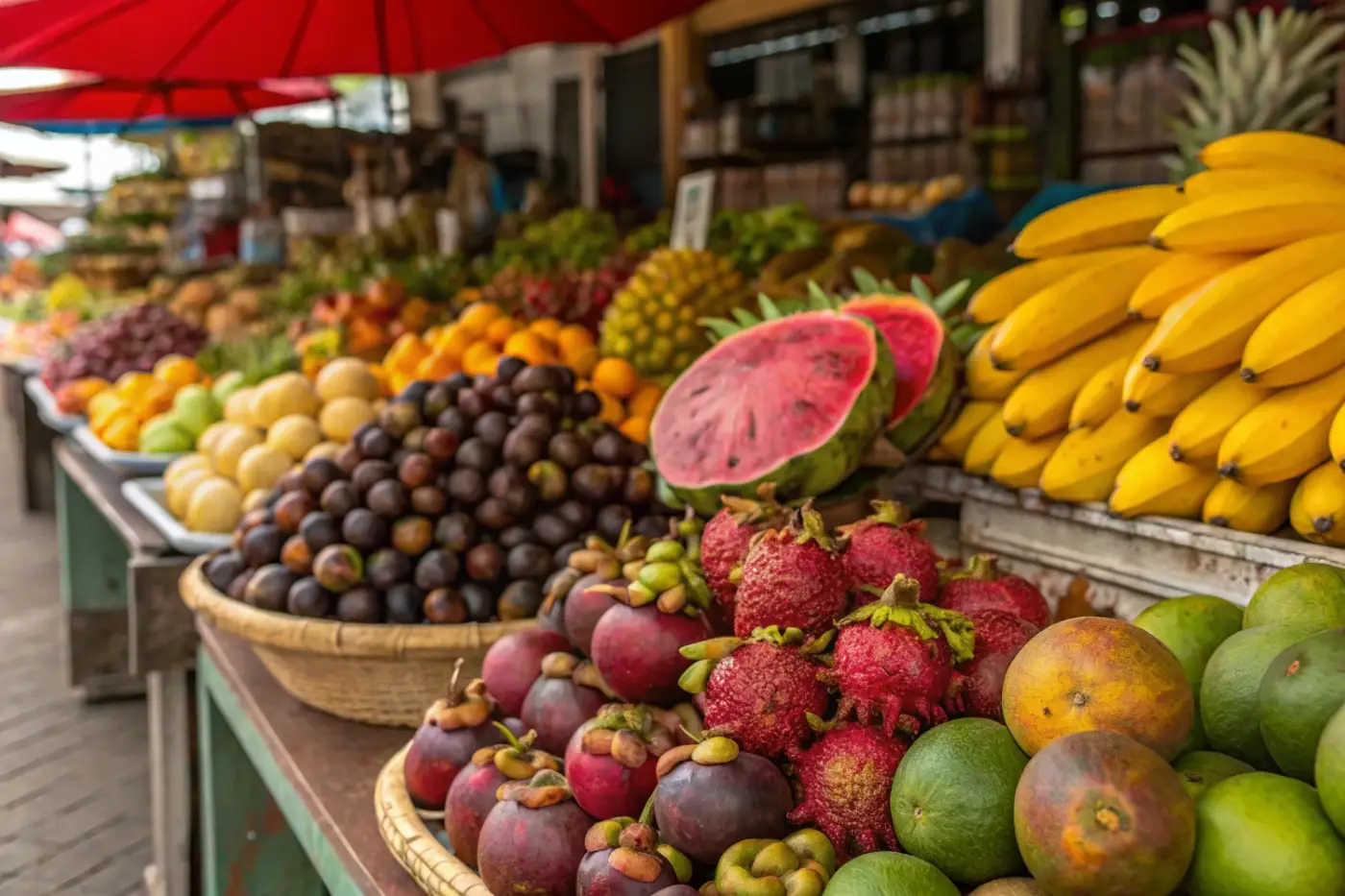Exploring the Unique World of Tropical Fruits
It’s a magical experience to walk into a crowded market with vibrant colors, captivating smells, and the sound of vendors selling their fresh fruits. As a frequent traveler, I’ve had the pleasure of tasting various exotic fruits in tropical destinations that are available from all over the world. Each has a distinct taste and deep connections to the culture of the country.
Tropical destinations such as Thailand, Indonesia, Brazil, and the Caribbean are filled with an array of fruits, some of which are not known to the common tourist. Filled with minerals, vitamins, as well as antioxidants, the fruit provides not only a flurry of flavor but also many health benefits.
In this guide, we’ll embark on a journey through the world’s most exotic fruits, exploring their origins, health benefits, and the best ways to enjoy them.
Table Of Contents
Table of Contents
Mangosteen – The Queen of Fruits
What is Mangosteen?
Mangosteen, often called the “queen of fruits,” is a tropical delicacy native to Southeast Asia, particularly Indonesia and Thailand. This fruit is instantly recognizable by its deep purple outer shell and delicate, juicy white flesh.
Health Benefits of Mangosteen
Rich in antioxidants, particularly xanthones, mangosteen has powerful anti-inflammatory properties. It helps improve digestion, strengthens the immune system, and promotes healthy skin.
How to Enjoy Mangosteen
Mangosteen is best enjoyed fresh, as its delicate flavor—a perfect balance of sweet and tart—is lost in processing. However, it can also be used in desserts, smoothies, and refreshing summer salads.
Rambutan – The Hairy Lychee
Origin and Description
It is a native of Malaysia and Indonesia The rambutan is akin to the lychee with hairs that are soft and spiky that cover its shell. Inside, the transparent juicy flesh has a slightly sweet and tangy flavor.
Nutritional Profile
This fruit is a fantastic supply of Vitamin C, fiber, and iron. It improves the immune system, enhances digestion, and supports healthy skin.
How to Eat Rambutan
Simply peel off the hairy skin, revealing the juicy fruit within. Rambutan is delicious fresh, or added to fruit salads or blended into smoothies with tropical flavors.
Dragon Fruit – The Vibrant Superfood

What is Dragon Fruit?
Also known as pitaya, dragon fruit is a visually striking fruit with pink or yellow skin and speckled white or red flesh. Originating from Central America, it is now widely grown in Vietnam and Thailand.
Health Benefits
Dragon fruit is rich in antioxidants, vitamin C, and fiber. It promotes gut health, boosts immunity, and helps hydrate the body due to its high water content.
Best Ways to Enjoy Dragon Fruit
Dragon fruit is incredibly versatile. It can be enjoyed fresh, blended into smoothies, made into sorbets, or used in tropical cocktails.
Looking for inspiration? Try these beach cocktail ideas featuring exotic fruits like dragon fruit and passion fruit!
Durian – The King of Controversial Fruits

A Unique and Polarizing Fruit
Durian, often called the “king of fruits,” is native to Southeast Asia and is infamous for its strong aroma—some love it, while others can’t stand it. Its spiky exterior hides a creamy, custard-like flesh with a sweet, slightly savory taste.
Nutritional Benefits
Durian is an energy powerhouse, loaded with healthy fats, carbohydrates, and vitamins like B6 and C. It also contains tryptophan, which promotes better sleep.
How to Eat Durian
Despite its pungent smell, durian is widely enjoyed fresh or used in desserts like ice cream, pancakes, and even milkshakes.
Jabuticaba – The Tree-Growing Berries
What is Jabuticaba?
Jabuticaba is a fascinating fruit native to Brazil, known for its unusual growth pattern—berries grow directly on the tree trunk rather than its branches. The dark purple fruits have a sweet, grape-like flavor.
Health Benefits
Jabuticaba is high in antioxidants, vitamin C, and anti-aging compounds, making it a great fruit for skin health and overall wellness.
How to Enjoy Jabuticaba
These berries are typically eaten fresh but can also be used to make jams, juices, and even wines.
Lúcuma – The Peruvian Superfruit
Where is Lúcuma Found?
Native to the Andean valleys of Peru, Chile, and Ecuador, lúcuma is known as the “gold of the Incas.” It has a dry, slightly sweet flesh with hints of caramel and maple.
Nutritional Profile
Lúcuma is packed with beta-carotene, fiber, iron, and calcium. It supports eye health, boosts immunity, and aids digestion.
How to Use Lúcuma in Dishes
Lúcuma is rarely eaten fresh due to its dry texture but is popularly used in smoothies, ice cream, and desserts.
For more tropical dessert inspiration, check out these beach picnic recipes featuring exotic fruits!
Passion Fruit – The Tropical Powerhouse

What is Passion Fruit?
Passion fruit is a small, round fruit with a wrinkled outer shell and a fragrant, jelly-like interior filled with edible seeds. It is commonly found in South America and the Caribbean.
Health Benefits
Passion fruit is an excellent source of vitamin A, vitamin C, and fiber, making it beneficial for skin health, digestion, and immunity.
Best Ways to Enjoy Passion Fruit
Scoop out the seeds and eat them fresh, blend them into smoothies, or add them to tropical cocktails.
Guava – A Sweet and Tangy Treat
What Makes Guava Special?
Guava is a common tropical fruit native to Central and South America. It comes in various colors, from pink to yellow, with a sweet and slightly tangy taste.
Health Benefits
This fruit is a vitamin C powerhouse, offering four times more vitamin C than oranges. It boosts immunity, aids digestion, and supports heart health.
How to Eat Guava
Guava can be eaten fresh, blended into juices, made into jams, or included in fruit salads.
Best Places to Try Exotic Fruits in Tropical Destinations
Southeast Asia – Thailand, Indonesia, and Vietnam
Markets in Thailand, such as Bangkok’s Or Tor Kor Market, are excellent places to try fresh mangosteen, durian, and dragon fruit. Vietnam, known for its dragon fruit farms, offers fresh, locally grown varieties.
South America – Brazil, Peru, and Colombia
Brazil is the best place to taste jabuticaba, while Peru is famous for its lúcuma-based desserts. Colombia is a paradise for exotic fruits like passion fruit and guava.
Caribbean Islands – Jamaica, Puerto Rico, and the Dominican Republic
The Caribbean is home to some of the freshest guavas, passion fruits, and unique fruits like the sapote.
Don’t miss our guide to eating like a local in Bali to discover more tropical delicacies!
FAQs
What are the most exotic tropical fruits to try?
Some of the best include mangosteen, dragon fruit, rambutan, durian, and jabuticaba.
Which tropical fruit is the healthiest?
Guava, dragon fruit, and passion fruit are among the most nutrient-dense tropical fruits.
How do you eat dragon fruit properly?
Cut it in half and scoop out the flesh with a spoon, or slice it into cubes for easy snacking.
Why is durian banned in some places?
Due to its strong odor, durian is banned in many hotels and public transportation in Southeast Asia.
Where can you find the best exotic fruits in tropical destinations?
Markets in Thailand, Vietnam, Brazil, and the Caribbean are the best places to explore exotic fruits.
Final Thoughts
Exploring exotic fruits in tropical destinations is an exciting and delicious experience that connects you with the rich traditions and cultures of every region. It doesn’t matter if you’re eating the freshest mangosteen in Thailand or sipping the passion fruit cocktails in the Caribbean fruit, they provide the perfect opportunity to taste the world.
Looking for more tropical food guides? Discover the best seaside delicacies from around the world!


